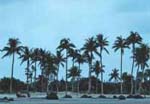 The moon or moonbeams have metaphorically been used myriad times in poetry, music, art and literature. Aesthetes who are in love with a mere glimpse of natural landscapes cannot but savour the beauty of a Blue Moon.
The moon or moonbeams have metaphorically been used myriad times in poetry, music, art and literature. Aesthetes who are in love with a mere glimpse of natural landscapes cannot but savour the beauty of a Blue Moon.
Friday, August 31, 2012 brought us the second of two full moons. Some almanacs assert that when two full moons occur within a calendar month, the second full moon is called the “Blue Moon.”
The idiom, “Once in a blue moon”, first surfaced in 1824 and refers to occurrences that are uncommon, though not truly rare. Yet, to have two full moons in the same month is not as uncommon as one might think. In fact, it occurs, on an average, about every 32 months.
As the next Blue Moon will appear in the sky on July 31, 2015, I along with a staff photo journalist, hurriedly booked a cabin in Parabat-7 prior to the “Blue Moon” night (August 30). Parabat-7 is not a turtle-dove or a pigeon, rather a gigantic maritime vessel that carries passengers on the Dhaka-Barisal water route. During our voyage we watched the moon half-circling the earth and enjoyed the grey reflections of moonlight on the river. The remote fishing boats bobbed up and down on the water as we passed while a mischievous moon blissfully played hide-and-seek with the wings of clouds. I was quoting from my favourite poet Jibanananda Das’ poem “Chandnitey”; the lines went “Babylon Kotha Haraye Giyechhey,- Mishor ‘Oshur’ Kuashakalo; Chand Jege Achhey Aajo Opolok,- Megher Palokey Dhalichhey Aalo” ( Where has Babylon passed into oblivion/ Egypt is enmeshed in dark mist/ Yet the moon is wide eyed/ pouring light unto the sight of the clouds). When the tired moon sleepily dived into the river Kirttankhola, we landed in Barisal.
On reaching Barisal, we quickly freshened up and had breakfast before getting into a Kuakata bound BRTC bus. We beheld the fresh foliage of several southern districts, including the ‘daughter’ of the sea Patuakhali, from the window of the bus. With the welcoming roars of the sea, we reached Kuakata by afternoon.
We dived into the low tide water, viewed the panoramic sunset and savoured fresh fried crabs along with coral fish. Meanwhile, the “Blue Moon” appeared on the eastern horizon with an ephemeral coloured ring.
The full moon that night shone bright but appeared no different from any other full moon… And the “Blue Moon” is not actually blue in colour. The photo editor seldom adds bluish impressions to it. But the moon may change colour in certain conditions. After forest fires or volcanic eruptions, the moon can appear to take on a bluish or even lavender hue. Soot and ash particles, deposited high in the earth’s atmosphere, can sometimes make the moon appear bluish.
Beholding the “Blue Moon” while roaming the Kuakata beach was quite an extraordinary experience! The songs of the swift wind coupled with the rhythmic roar of sea waves drenched us along the seashore. I felt like a ‘Chokor'( mythical bird symbolic of longing for moonlight) and loudly recited a verse “Hoyto Tahara Dupur-Jamini Balur Jajim-e Sagar Teer-e- Chader Aaloye Digdigantey Chokor-er Moto Chorito Phirey” from “Chandinitey” by Jibanananda Das. Photographing the beautiful landscapes was prompt and spontaneous. Clouds generated abstract images every now and then, mingling with the moonlight.
Yet life and living was there too. Most residents of the region kept busy with fishing at midnight. With an engine run dingi, they scoured the sea waters till morning in the hope of a good catch. As the “Blue Moon” went under sea water, we longed for the spectacular sunrise. But the conspiracy of clouds frustrated our hopes. So we were delighted to be drenched in the serenading rains and dived into the high tide of the sea. After taking a long shower on the seashore, the bells of time reminded us of our return to Dhaka, only fuelling an overwhelming desire to revisit the beach once more!
Courtesy of The Daily Star




















